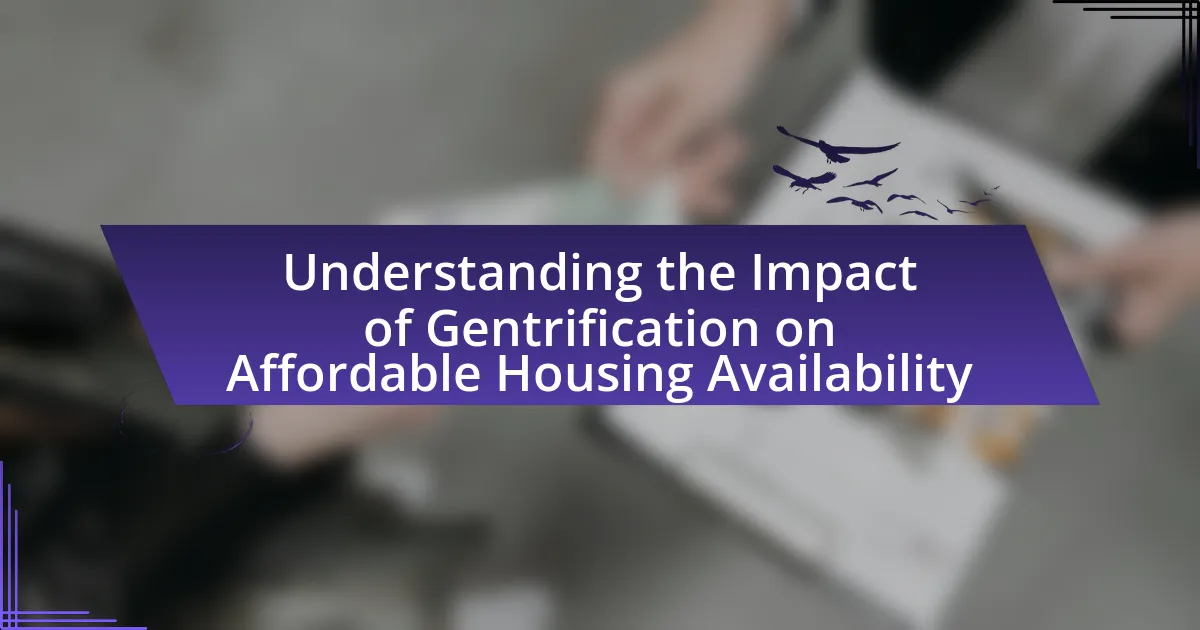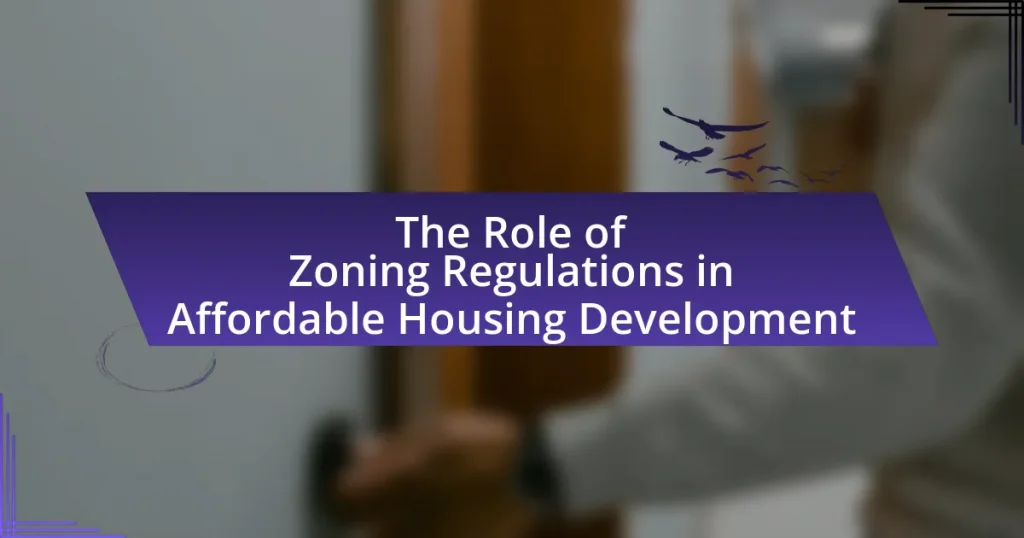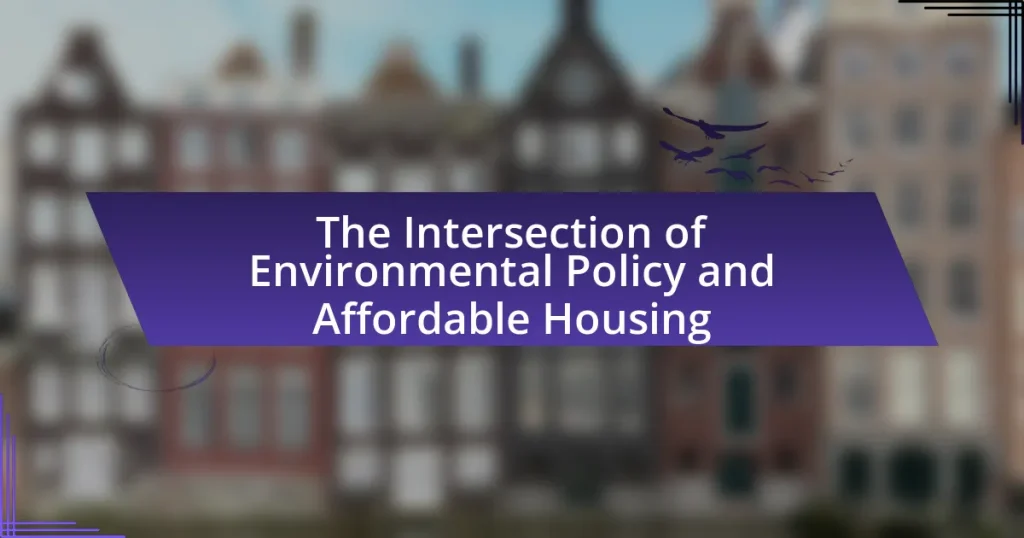The article examines the impact of gentrification on affordable housing availability, highlighting how the influx of wealthier residents into lower-income neighborhoods leads to increased property values and rents, ultimately displacing long-term residents. It discusses the socio-economic transformation of neighborhoods, the characteristics of gentrifying areas, and the economic implications for housing markets. Additionally, the article explores the social consequences of gentrification, including the disruption of community ties and cultural identity, while also addressing potential responses and strategies to mitigate these effects, such as community land trusts and inclusionary zoning policies.
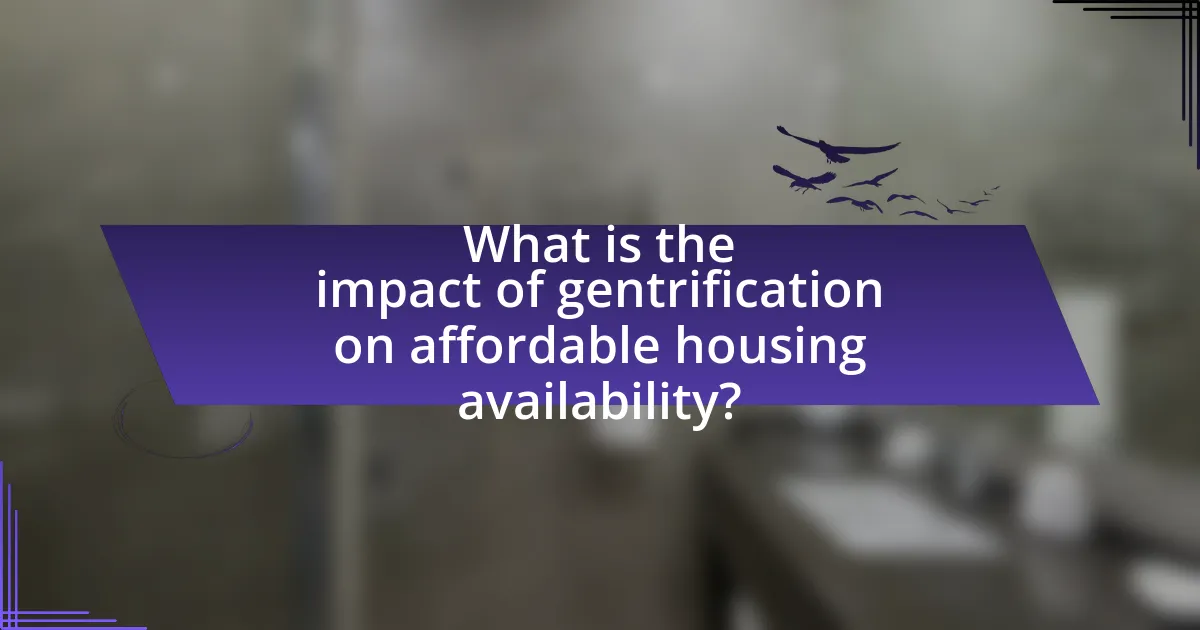
What is the impact of gentrification on affordable housing availability?
Gentrification significantly reduces the availability of affordable housing. As wealthier individuals move into previously lower-income neighborhoods, property values and rents increase, displacing long-term residents and limiting their access to affordable housing options. A study by the National Community Reinvestment Coalition found that gentrifying neighborhoods experienced a 30% increase in rents, which directly correlates with a decrease in affordable housing units. This trend exacerbates housing insecurity for low-income families, making it increasingly difficult for them to remain in their communities.
How does gentrification redefine neighborhoods?
Gentrification redefines neighborhoods by transforming their socio-economic landscape, often leading to increased property values and a shift in the demographic composition. This process typically involves the influx of higher-income residents, which can displace long-standing, lower-income communities. For instance, a study by the Federal Reserve Bank of Philadelphia found that neighborhoods experiencing gentrification saw property values rise by an average of 30% over a decade, significantly altering the affordability of housing in those areas. Consequently, the cultural identity of neighborhoods may change, as new businesses and amenities cater to the preferences of wealthier residents, further marginalizing existing communities.
What are the key characteristics of gentrifying neighborhoods?
Gentrifying neighborhoods are characterized by an influx of higher-income residents, rising property values, and the displacement of lower-income families. This transformation often leads to increased investment in local infrastructure, such as improved public services and amenities, which can enhance the overall quality of life. Additionally, gentrifying areas typically experience a shift in the demographic composition, with a more diverse population emerging as new businesses cater to the tastes and preferences of the incoming residents. According to a study by the Federal Reserve Bank of Philadelphia, neighborhoods undergoing gentrification often see a significant increase in housing prices, which can lead to the displacement of long-term residents who can no longer afford to live in the area.
How does the influx of higher-income residents affect local demographics?
The influx of higher-income residents typically leads to demographic shifts in local communities, often resulting in increased property values and changes in the socioeconomic landscape. This demographic change can displace lower-income residents, as seen in cities like San Francisco, where the median home price rose by over 70% from 2010 to 2020, pushing many long-term residents out of their neighborhoods. Additionally, the arrival of higher-income individuals often brings new businesses and amenities that cater to wealthier populations, further altering the community’s character and potentially leading to a decline in cultural diversity.
What are the economic implications of gentrification on housing markets?
Gentrification leads to increased property values and rents in housing markets, often displacing lower-income residents. As wealthier individuals move into previously affordable neighborhoods, demand for housing rises, resulting in higher prices. A study by the National Community Reinvestment Coalition found that gentrifying neighborhoods experienced a 20% increase in home prices compared to non-gentrifying areas. This economic shift can reduce the availability of affordable housing, as landlords may convert rental units into higher-priced properties to capitalize on the increased demand. Consequently, gentrification can exacerbate socioeconomic disparities, limiting access to housing for lower-income populations.
How does gentrification influence property values and rents?
Gentrification increases property values and rents in urban neighborhoods as higher-income residents move in, driving demand for housing. This influx often leads to renovations and new developments, which further elevate property prices. For example, a study by the National Community Reinvestment Coalition found that neighborhoods experiencing gentrification saw property values rise by an average of 30% over a decade. Consequently, existing residents may face displacement due to rising rents, as landlords capitalize on the increased market value.
What role do developers play in the gentrification process?
Developers play a crucial role in the gentrification process by initiating real estate projects that often lead to increased property values and the displacement of lower-income residents. Their investments in urban areas typically involve renovating existing buildings or constructing new ones, which attracts higher-income individuals and businesses. This transformation can result in a shift in the neighborhood’s demographic and economic landscape, as evidenced by studies showing that areas undergoing gentrification often see a significant rise in housing prices—sometimes by as much as 20% to 30% within a few years. Consequently, the influx of wealthier residents can push out long-standing, lower-income communities, exacerbating the affordable housing crisis.
What social consequences arise from gentrification?
Gentrification leads to significant social consequences, primarily the displacement of long-term residents and changes in community demographics. As property values and rents increase, lower-income families often cannot afford to remain in their neighborhoods, resulting in their relocation to less desirable areas. This displacement disrupts established social networks and community cohesion, as residents lose access to familiar support systems and local resources. Additionally, gentrification can lead to cultural homogenization, where the unique characteristics of a neighborhood are replaced by those of wealthier newcomers, diminishing the cultural diversity that originally defined the area. Studies have shown that neighborhoods undergoing gentrification often experience increased tensions between new and existing residents, further exacerbating social divides.
How does gentrification impact long-term residents and their communities?
Gentrification significantly impacts long-term residents and their communities by displacing them due to rising housing costs and altering the social fabric. As new, often wealthier residents move into a neighborhood, property values and rents increase, making it unaffordable for existing residents to remain. For instance, a study by the National Community Reinvestment Coalition found that neighborhoods experiencing gentrification saw a 20% increase in rent prices, which disproportionately affects low-income families. Additionally, the influx of new businesses catering to wealthier residents can lead to the closure of long-standing local shops, further eroding community ties and cultural identity.
What are the effects on local businesses and cultural identity?
Gentrification significantly impacts local businesses and cultural identity by often displacing long-standing establishments and altering the community’s character. As wealthier residents move into an area, local businesses that cater to the original community may struggle to survive due to rising rents and changing consumer preferences. For instance, a study by the National Community Reinvestment Coalition found that gentrification can lead to a 30% increase in commercial rents, which disproportionately affects small, locally-owned businesses. Additionally, cultural identity may be diluted as new developments prioritize upscale amenities over traditional community features, leading to a loss of historical and cultural significance. This transformation can result in a homogenized environment that lacks the unique characteristics that originally defined the neighborhood.
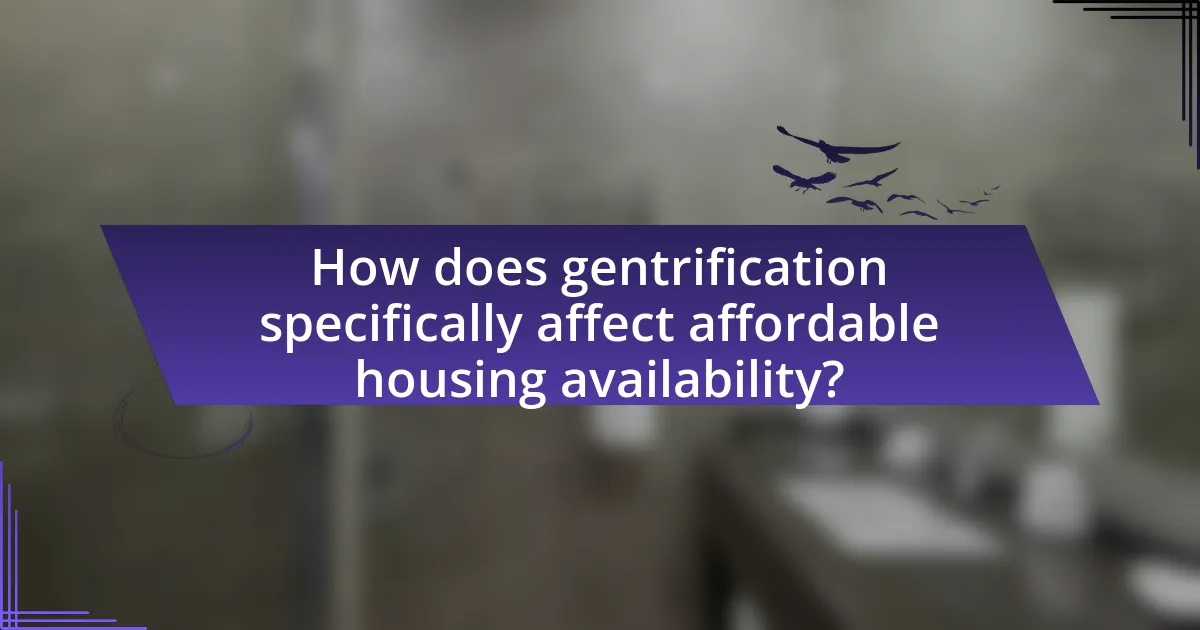
How does gentrification specifically affect affordable housing availability?
Gentrification reduces affordable housing availability by increasing property values and rents in previously low-income neighborhoods. As wealthier individuals move into these areas, demand for housing rises, leading to higher costs that displace long-term residents. A study by the National Community Reinvestment Coalition found that gentrifying neighborhoods saw a 20% increase in rents, making it difficult for low-income families to afford housing. This process often results in the conversion of affordable units into higher-end developments, further exacerbating the housing crisis for vulnerable populations.
What are the mechanisms through which gentrification reduces affordable housing?
Gentrification reduces affordable housing primarily through increased property values and rents, which displaces lower-income residents. As wealthier individuals move into a neighborhood, demand for housing rises, leading to higher prices. This process often results in the conversion of rental units into higher-end properties, further diminishing the stock of affordable housing. For instance, a study by the National Community Reinvestment Coalition found that neighborhoods experiencing gentrification saw a 20% increase in rents, making it financially unfeasible for many long-term residents to remain. Additionally, the influx of new businesses catering to affluent residents can drive up local prices, exacerbating the affordability crisis.
How do rising rents correlate with the displacement of low-income residents?
Rising rents directly correlate with the displacement of low-income residents, as increased housing costs often exceed their financial capabilities. When rents rise, low-income individuals and families frequently cannot afford to remain in their neighborhoods, leading to forced relocation. For instance, a study by the National Low Income Housing Coalition found that in many urban areas, a significant percentage of low-income renters spend over 30% of their income on housing, making them vulnerable to displacement when rents increase. This economic pressure results in a loss of affordable housing options, exacerbating the housing crisis for low-income populations.
What policies contribute to the loss of affordable housing during gentrification?
Policies that contribute to the loss of affordable housing during gentrification include zoning changes, tax incentives for developers, and the reduction of rent control measures. Zoning changes often allow for higher-density developments that prioritize luxury housing over affordable units, leading to displacement of lower-income residents. Tax incentives for developers, such as tax abatements, encourage the construction of high-end properties, which can drive up property values and rents in surrounding areas. Additionally, the reduction or elimination of rent control measures can result in increased rents for existing tenants, further exacerbating the loss of affordable housing. For instance, a study by the National Low Income Housing Coalition found that areas with weakened rent control laws experienced significant rent increases, contributing to the displacement of low-income families.
What are the responses to the challenges posed by gentrification?
Responses to the challenges posed by gentrification include community land trusts, affordable housing policies, and tenant protections. Community land trusts allow communities to collectively own land, ensuring long-term affordability and preventing displacement. Affordable housing policies, such as inclusionary zoning, require developers to allocate a percentage of new units for low-income residents, thereby increasing the availability of affordable housing. Tenant protections, including rent control and eviction protections, help safeguard existing residents from displacement due to rising rents. These strategies have been implemented in various cities, demonstrating their effectiveness in mitigating the negative impacts of gentrification on affordable housing availability.
How can communities advocate for affordable housing preservation?
Communities can advocate for affordable housing preservation by organizing grassroots campaigns that raise awareness about the importance of maintaining existing affordable housing stock. These campaigns can include public meetings, social media outreach, and partnerships with local organizations to mobilize residents and stakeholders. Evidence shows that cities with active community engagement, such as San Francisco, have successfully implemented policies to protect affordable housing through tenant protections and zoning regulations, demonstrating the effectiveness of organized advocacy efforts.
What role do local governments play in mitigating gentrification effects?
Local governments play a crucial role in mitigating the effects of gentrification by implementing policies that protect affordable housing and support existing residents. They can enact rent control measures, provide subsidies for low-income housing, and promote community land trusts to ensure that housing remains accessible. For instance, cities like San Francisco have adopted inclusionary zoning laws that require developers to include affordable units in new projects, thereby countering displacement. Additionally, local governments can invest in community development initiatives that enhance neighborhood amenities without displacing current residents, as seen in programs aimed at improving public infrastructure while preserving the character of the community. These actions demonstrate how local governments can actively shape urban development to balance growth with the needs of existing populations.

What strategies can be implemented to address the impact of gentrification on affordable housing?
To address the impact of gentrification on affordable housing, implementing inclusionary zoning policies is essential. Inclusionary zoning requires developers to allocate a percentage of new housing units for low- and moderate-income residents, thereby increasing the availability of affordable housing in gentrifying neighborhoods. For instance, cities like San Francisco and New York have adopted such policies, resulting in the creation of thousands of affordable units. Additionally, establishing community land trusts can help maintain long-term affordability by removing land from the speculative market, as demonstrated by successful models in Burlington, Vermont. Furthermore, providing financial incentives for the rehabilitation of existing affordable housing can prevent displacement, as seen in programs that offer tax credits for landlords who maintain lower rents. These strategies collectively aim to mitigate the adverse effects of gentrification on housing affordability.
What best practices exist for maintaining affordable housing in gentrifying areas?
Best practices for maintaining affordable housing in gentrifying areas include implementing rent control policies, promoting community land trusts, and increasing funding for affordable housing development. Rent control policies help stabilize housing costs, preventing displacement of low-income residents. Community land trusts allow communities to collectively own land, ensuring long-term affordability and preventing speculative price increases. Additionally, increasing funding for affordable housing development through government grants or public-private partnerships can create new units that cater to low-income families, addressing the supply-demand imbalance often exacerbated by gentrification. These strategies have been shown to effectively mitigate the negative impacts of gentrification on housing availability.
How can community land trusts help preserve affordable housing?
Community land trusts (CLTs) help preserve affordable housing by removing land from the speculative real estate market and ensuring long-term affordability. By acquiring land and holding it in trust, CLTs can develop or maintain housing that is affordable to low- and moderate-income families, effectively countering the pressures of gentrification. For example, a study by the Lincoln Institute of Land Policy found that CLTs can stabilize neighborhoods by providing affordable housing options, which helps prevent displacement of existing residents. This model allows for community control over land use and housing development, ensuring that the benefits of affordable housing are retained within the community over time.
What are the benefits of inclusionary zoning policies?
Inclusionary zoning policies provide several benefits, primarily by increasing the availability of affordable housing within communities. These policies require developers to include a percentage of affordable units in new housing projects, which helps to create mixed-income neighborhoods. Research indicates that areas with inclusionary zoning experience a more equitable distribution of housing options, reducing economic segregation. For instance, a study by the Urban Institute found that cities implementing such policies saw a significant increase in affordable housing stock, with some areas reporting up to a 15% increase in affordable units over a decade. This approach not only addresses housing shortages but also fosters social diversity and stability in neighborhoods, contributing to overall community resilience.
What lessons can be learned from cities that have successfully managed gentrification?
Cities that have successfully managed gentrification demonstrate the importance of inclusive development policies. These cities often implement strategies such as community land trusts, which help maintain affordable housing by allowing communities to own and manage land collectively. For instance, in Burlington, Vermont, the establishment of a community land trust has preserved over 200 affordable homes, ensuring long-term affordability despite rising property values. Additionally, successful cities prioritize tenant protections and rent control measures, as seen in San Francisco, where policies have been enacted to protect low-income residents from displacement. These approaches highlight the necessity of balancing economic development with the preservation of affordable housing to mitigate the negative impacts of gentrification.
What innovative approaches have been taken to balance development and affordability?
Innovative approaches to balance development and affordability include the implementation of inclusionary zoning policies, community land trusts, and the use of public-private partnerships. Inclusionary zoning mandates that a percentage of new housing developments be set aside for affordable units, which has been adopted in cities like San Francisco, resulting in thousands of affordable homes being created alongside market-rate developments. Community land trusts, such as those in Burlington, Vermont, allow communities to collectively own land and ensure long-term affordability by removing it from the speculative market. Public-private partnerships leverage resources from both sectors to fund affordable housing projects, exemplified by initiatives in New York City that have successfully combined private investment with public funding to create mixed-income developments. These approaches demonstrate effective strategies to mitigate the impacts of gentrification while promoting sustainable urban growth.
How can community engagement shape effective housing policies?
Community engagement can shape effective housing policies by ensuring that the voices and needs of residents are incorporated into decision-making processes. When local communities actively participate in discussions about housing, they provide valuable insights into their unique challenges and preferences, which can lead to policies that are more responsive and equitable. For instance, studies have shown that cities with strong community engagement frameworks, such as participatory budgeting initiatives, often see improved housing outcomes and increased satisfaction among residents. Engaging communities can also help identify specific areas affected by gentrification, allowing policymakers to tailor interventions that protect affordable housing and support vulnerable populations.
What practical steps can individuals take to support affordable housing initiatives?
Individuals can support affordable housing initiatives by advocating for policy changes that promote affordable housing development. Engaging with local government meetings and expressing support for zoning reforms can help create more opportunities for affordable housing projects. Additionally, individuals can volunteer with or donate to organizations focused on affordable housing, such as Habitat for Humanity, which builds homes for low-income families. Research indicates that community involvement in housing policy can lead to more equitable housing solutions, as seen in cities that have successfully implemented inclusionary zoning laws, which require a percentage of new developments to be affordable.
